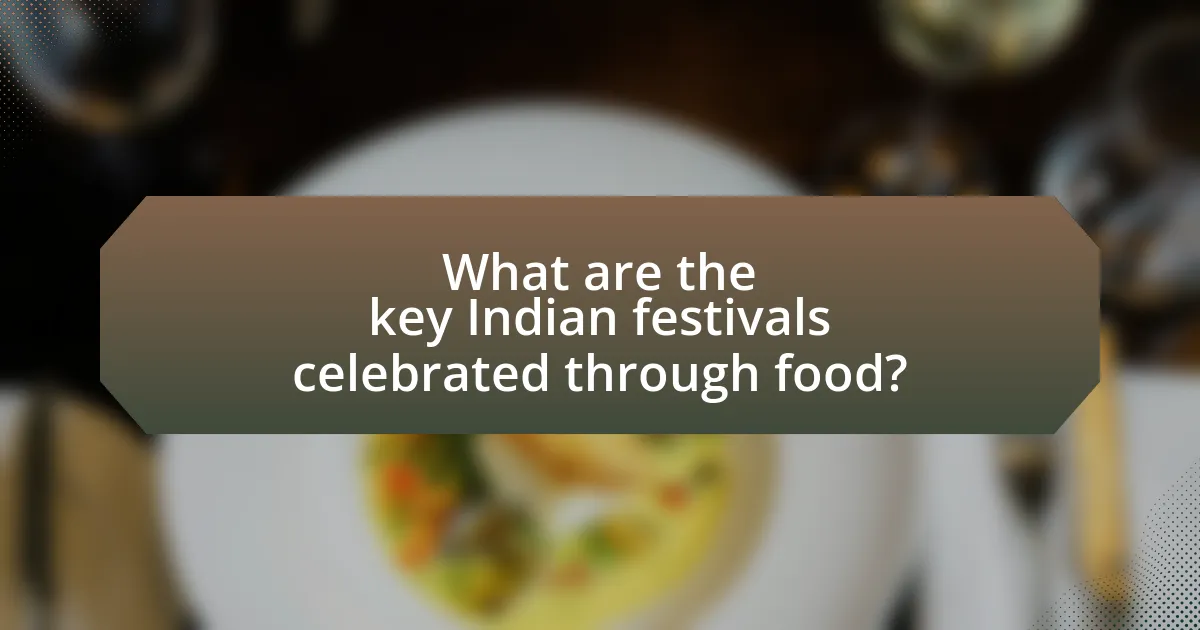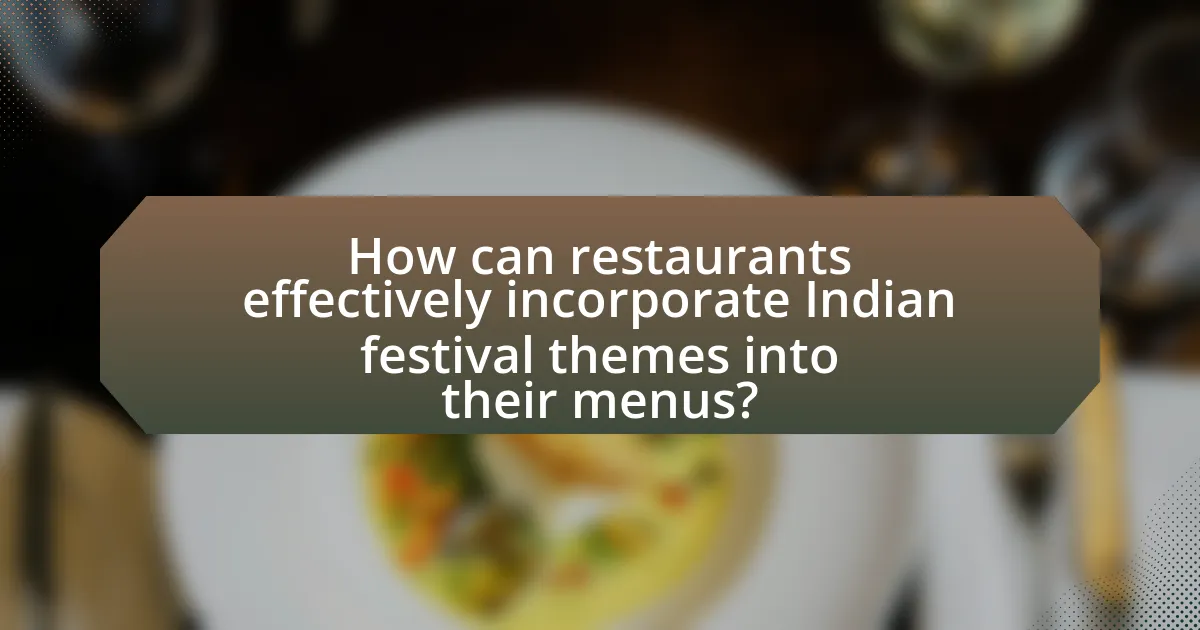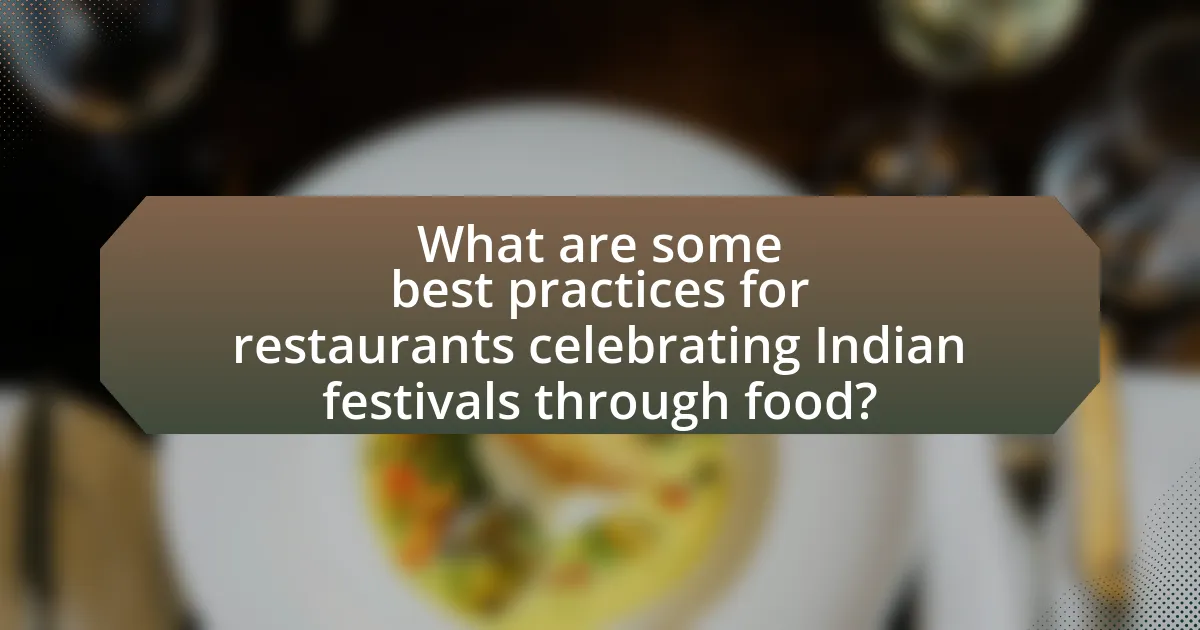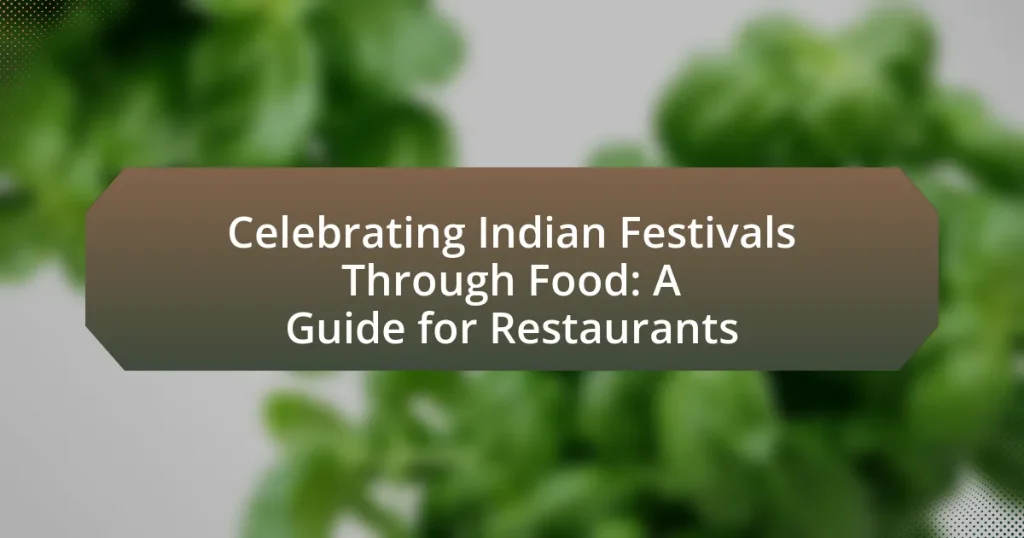The article focuses on the celebration of Indian festivals through food, highlighting the significance of traditional dishes associated with major festivals such as Diwali, Holi, Eid, Pongal, and Navratri. It explores how different regions in India have unique culinary traditions that reflect their cultural heritage, emphasizing the role of food in community bonding and cultural identity. The article also addresses the challenges restaurants face in sourcing authentic ingredients and creating festival-specific menus, while providing strategies for effectively incorporating festival themes into their offerings. Additionally, it discusses the importance of customer feedback and community engagement in enhancing the dining experience during festive celebrations.

What are the key Indian festivals celebrated through food?
Key Indian festivals celebrated through food include Diwali, Holi, Eid, Pongal, and Navratri. During Diwali, sweets like ladoos and barfis are prepared to symbolize prosperity and joy. Holi features colorful dishes such as gujiya and thandai, representing the arrival of spring. Eid is marked by the preparation of biryani and seviyan, celebrating the end of Ramadan. Pongal involves cooking the dish of the same name, symbolizing the harvest season. Navratri includes fasting foods and special dishes like sabudana khichdi, honoring the goddess Durga. Each festival has distinct culinary traditions that reflect cultural significance and regional diversity in India.
How do different regions in India celebrate festivals with food?
Different regions in India celebrate festivals with distinct culinary traditions that reflect their cultural heritage. For example, in Punjab, during Baisakhi, people enjoy dishes like sarson da saag and makki di roti, symbolizing the harvest season. In West Bengal, Durga Puja is marked by the preparation of traditional sweets like sandesh and mishti doi, showcasing the region’s rich dessert culture. In the South, Onam is celebrated with a grand feast called Onam Sadhya, featuring a variety of vegetarian dishes served on a banana leaf, emphasizing the importance of communal dining. Each region’s unique ingredients and cooking methods during festivals highlight the diversity of Indian cuisine and its deep-rooted connection to cultural celebrations.
What traditional dishes are associated with major Indian festivals?
Traditional dishes associated with major Indian festivals include sweets like Gulab Jamun during Diwali, Puran Poli during Gudi Padwa, and Biryani during Eid. These dishes are integral to the celebrations, reflecting cultural significance and regional diversity. For instance, Gulab Jamun, made from milk solids, symbolizes joy and is a staple during the festival of lights, Diwali, celebrated by millions across India. Puran Poli, a sweet flatbread filled with lentils and jaggery, is traditionally prepared during Gudi Padwa, marking the Marathi New Year. Biryani, a fragrant rice dish with meat or vegetables, is commonly served during Eid, celebrating the end of Ramadan. Each dish not only enhances the festive experience but also showcases the rich culinary heritage of India.
How do cultural influences shape festival foods in India?
Cultural influences significantly shape festival foods in India by dictating the ingredients, preparation methods, and rituals associated with various celebrations. For instance, during Diwali, the festival of lights, sweets like ladoos and barfis are prepared, reflecting the Hindu tradition of sharing joy and prosperity. Similarly, during Eid, dishes such as biryani and sheer khurma are made, showcasing the Islamic heritage and culinary practices. Regional variations also play a crucial role; for example, in South India, Pongal is celebrated with rice dishes flavored with jaggery and coconut, while in the North, the same festival may feature different sweets and savory items. These practices are rooted in historical, religious, and social contexts, illustrating how diverse cultural backgrounds contribute to the rich tapestry of Indian festival foods.
Why is food an integral part of Indian festival celebrations?
Food is an integral part of Indian festival celebrations because it symbolizes cultural heritage, community bonding, and religious significance. Each festival features specific dishes that reflect regional traditions and seasonal ingredients, such as sweets during Diwali or rice dishes during Pongal. These culinary practices foster social connections, as families and communities gather to prepare and share meals, reinforcing relationships and cultural identity. Additionally, many Indian festivals are rooted in religious rituals where food offerings, known as prasad, are made to deities, highlighting the spiritual importance of food in these celebrations.
What role does food play in community bonding during festivals?
Food serves as a central element in community bonding during festivals by fostering social interactions and shared experiences among participants. During Indian festivals, communal meals and traditional dishes are often prepared and shared, creating a sense of belonging and unity. For instance, during Diwali, families and neighbors exchange sweets and snacks, reinforcing relationships and cultural ties. This practice is supported by research indicating that shared meals enhance social cohesion and strengthen community bonds, as seen in studies conducted by the Journal of Community Psychology, which highlight the importance of food in social gatherings for building trust and cooperation among individuals.
How does food reflect the cultural heritage of Indian festivals?
Food reflects the cultural heritage of Indian festivals by embodying traditional recipes, regional ingredients, and symbolic meanings associated with various celebrations. Each festival, such as Diwali or Eid, features specific dishes that have historical significance and are often prepared using age-old techniques passed down through generations. For instance, during Diwali, sweets like ladoos and barfis are made to symbolize prosperity and joy, while during Eid, biryani and sheer khurma are prepared to celebrate community and sharing. These culinary practices not only preserve cultural identities but also foster communal bonds, as families and communities come together to prepare and share these festive foods, reinforcing the social fabric of Indian society.
What are the challenges restaurants face in celebrating Indian festivals through food?
Restaurants face several challenges in celebrating Indian festivals through food, primarily including ingredient sourcing, menu adaptation, and cultural authenticity. Sourcing authentic ingredients can be difficult due to limited availability, especially for regional specialties that are integral to festival cuisine. Additionally, restaurants must adapt their menus to reflect the diverse culinary traditions associated with various festivals, which can require significant research and development to ensure accuracy. Cultural authenticity is another challenge, as restaurants must balance traditional recipes with modern dietary preferences and restrictions, ensuring that the essence of the festival is preserved while catering to a broader audience. These challenges highlight the complexities involved in effectively celebrating Indian festivals through food in a restaurant setting.
How can restaurants source authentic ingredients for festival dishes?
Restaurants can source authentic ingredients for festival dishes by establishing direct relationships with local farmers and suppliers who specialize in traditional crops and spices. This approach ensures access to high-quality, region-specific ingredients that reflect the cultural significance of the festival. For instance, sourcing saffron from Kashmir or specific lentils from local farms can enhance the authenticity of dishes served during Indian festivals. Additionally, participating in farmers’ markets and food co-ops can provide restaurants with fresh, seasonal produce that aligns with festival themes, further supporting local agriculture and promoting sustainability.
What are the common pitfalls in menu planning for festival celebrations?
Common pitfalls in menu planning for festival celebrations include lack of cultural relevance, overcomplication of dishes, and inadequate consideration of dietary restrictions. Cultural relevance is crucial; failing to incorporate traditional foods can alienate attendees, as seen in festivals like Diwali where specific sweets and savory items are expected. Overcomplicating dishes can lead to longer preparation times and increased costs, which can detract from the festive experience. Additionally, neglecting dietary restrictions, such as vegetarian or gluten-free options, can limit participation and enjoyment, as approximately 30% of the Indian population identifies as vegetarian. These pitfalls can significantly impact the success of festival celebrations.

How can restaurants effectively incorporate Indian festival themes into their menus?
Restaurants can effectively incorporate Indian festival themes into their menus by offering traditional dishes that are specific to each festival, such as Diwali sweets like ladoos and holi snacks like gujiya. This approach not only honors cultural significance but also attracts customers seeking authentic experiences. For instance, during Diwali, restaurants can create special thalis featuring items like paneer tikka and biryani, while including festive decorations and themed events to enhance the dining experience. Additionally, using locally sourced ingredients and promoting limited-time offers can further engage customers and create a sense of urgency. This strategy aligns with the growing trend of experiential dining, where consumers are increasingly looking for unique and culturally rich culinary experiences.
What strategies can restaurants use to create festival-specific menus?
Restaurants can create festival-specific menus by incorporating traditional dishes that reflect the cultural significance of the festival. This involves researching the specific foods associated with each festival, such as sweets for Diwali or savory snacks for Holi, and adapting them to fit the restaurant’s style while maintaining authenticity. For instance, during Diwali, restaurants can offer a range of mithai (sweets) and festive thalis that include items like puris and chole, which are commonly enjoyed during the celebration. Additionally, restaurants can engage with local communities to gather insights on popular festival foods, ensuring the menu resonates with customers. This approach not only enhances the dining experience but also fosters a connection to cultural traditions, making the restaurant a go-to destination during festival seasons.
How can seasonal ingredients enhance festival menu offerings?
Seasonal ingredients can significantly enhance festival menu offerings by providing freshness, flavor, and cultural relevance. Utilizing ingredients that are in season ensures that dishes are made with the highest quality produce, which can elevate the overall taste and presentation of the food. For instance, during the monsoon season in India, ingredients like fresh greens and lentils are abundant, allowing restaurants to create traditional dishes that resonate with the season’s culinary practices. Additionally, seasonal ingredients often reflect local agricultural cycles, fostering a connection between the festival and the community’s food heritage. This approach not only supports local farmers but also aligns with the growing consumer preference for sustainable and locally sourced food, making the festival experience more authentic and memorable.
What are some creative presentation ideas for festival dishes?
Creative presentation ideas for festival dishes include using traditional Indian serving ware, such as brass or clay pots, to enhance authenticity. Additionally, incorporating vibrant colors through garnishes like edible flowers or microgreens can elevate visual appeal. Arranging dishes in a thali format allows for a variety of flavors and textures to be showcased together, reflecting the diversity of Indian cuisine. Using banana leaves as serving platters not only adds a rustic touch but also aligns with eco-friendly practices. Finally, incorporating themed decorations, such as diyas or rangoli patterns, around the dish can create an immersive dining experience that resonates with the festive spirit.
How can restaurants promote their festival-themed offerings?
Restaurants can promote their festival-themed offerings by utilizing targeted marketing strategies such as social media campaigns, special events, and collaborations with local influencers. Social media platforms like Instagram and Facebook allow restaurants to showcase visually appealing dishes and engage with customers through festive posts, contests, and live cooking demonstrations. Special events, such as themed nights or cooking classes, can attract customers looking for unique dining experiences during festivals. Collaborating with local influencers can expand reach and credibility, as influencers can share their experiences with their followers, driving traffic to the restaurant. According to a study by the National Restaurant Association, 70% of consumers are influenced by social media when choosing where to eat, highlighting the effectiveness of these promotional strategies.
What marketing channels are most effective for reaching customers during festivals?
Social media platforms are the most effective marketing channels for reaching customers during festivals. These platforms, such as Facebook, Instagram, and Twitter, allow restaurants to engage with their audience through targeted ads, festive promotions, and visually appealing content that highlights special festival menus. According to a report by Hootsuite, 54% of social media users use these platforms to research products, making them a crucial touchpoint for restaurants aiming to attract customers during festive seasons. Additionally, email marketing remains effective, with a study from Campaign Monitor indicating that for every $1 spent on email marketing, businesses can expect an average return of $44, further validating its importance in reaching customers during festivals.
How can social media be leveraged to showcase festival food specials?
Social media can be leveraged to showcase festival food specials by utilizing visually appealing content, engaging storytelling, and targeted advertising. Restaurants can post high-quality images and videos of their festival dishes, which attract attention and encourage sharing. Engaging storytelling about the cultural significance of the food can enhance connection with the audience. Additionally, targeted ads can reach specific demographics interested in festival celebrations, increasing visibility and customer engagement. According to a study by Sprout Social, posts with images receive 650% higher engagement than text-only posts, highlighting the effectiveness of visual content in social media marketing.

What are some best practices for restaurants celebrating Indian festivals through food?
Restaurants celebrating Indian festivals through food should focus on incorporating traditional dishes, utilizing seasonal ingredients, and creating a culturally immersive dining experience. Traditional dishes like biryani for Eid or sweets like ladoos for Diwali resonate with festival themes and enhance authenticity. Seasonal ingredients, such as fresh fruits and vegetables, not only elevate the flavor but also align with the festival’s significance, as many Indian festivals celebrate harvests. Additionally, creating an immersive experience through decor, music, and themed events can engage customers and foster a deeper connection to the cultural aspects of the festival. These practices not only attract patrons but also honor the rich culinary heritage associated with Indian festivals.
How can restaurants ensure authenticity in their festival dishes?
Restaurants can ensure authenticity in their festival dishes by sourcing traditional ingredients and employing authentic cooking techniques. Utilizing locally sourced spices, grains, and vegetables that are specific to the festival’s regional cuisine enhances the dish’s genuine flavor profile. For example, using fresh turmeric and mustard oil in Bengali dishes during Durga Puja reflects the authentic culinary practices of that culture. Additionally, training chefs in traditional methods, such as slow cooking or specific marination techniques, preserves the integrity of the dish. Research indicates that authenticity in food significantly influences customer satisfaction and loyalty, as diners often seek genuine cultural experiences through cuisine.
What training do staff need to effectively serve festival-themed menus?
Staff need training in cultural awareness, menu knowledge, and customer service skills to effectively serve festival-themed menus. Cultural awareness training ensures that staff understand the significance of various Indian festivals, which enhances their ability to engage with customers meaningfully. Menu knowledge training focuses on the specific dishes associated with each festival, including ingredients, preparation methods, and presentation styles, allowing staff to provide accurate information and recommendations. Customer service skills training emphasizes the importance of creating a festive atmosphere and responding to customer inquiries with enthusiasm and respect. This comprehensive training approach is essential for delivering an authentic and enjoyable dining experience during Indian festivals.
How can customer feedback be utilized to improve festival offerings?
Customer feedback can be utilized to improve festival offerings by systematically collecting and analyzing responses to enhance menu items, service quality, and overall festival experience. Restaurants can implement surveys or feedback forms during and after festivals to gather insights on customer preferences, satisfaction levels, and suggestions for improvement. For instance, a study by the Journal of Hospitality and Tourism Management found that 70% of customers are more likely to return to a restaurant that actively seeks and acts on feedback. By addressing specific concerns or popular requests highlighted in the feedback, restaurants can tailor their offerings to better meet customer expectations, ultimately leading to increased customer loyalty and higher attendance at future festivals.
What are the key takeaways for restaurants looking to celebrate Indian festivals through food?
Restaurants looking to celebrate Indian festivals through food should focus on incorporating traditional dishes, utilizing seasonal ingredients, and creating a festive ambiance. Traditional dishes like biryani for Eid or sweets like ladoos for Diwali resonate with cultural significance and attract customers. Seasonal ingredients enhance authenticity and flavor, aligning with the festival’s themes. Additionally, a festive ambiance, including decorations and themed events, enhances the dining experience, making it memorable for patrons. These strategies not only honor the cultural heritage but also drive customer engagement and satisfaction during festive periods.
How can restaurants create a memorable dining experience during festivals?
Restaurants can create a memorable dining experience during festivals by offering themed menus that reflect the cultural significance of the celebration. For instance, during Diwali, restaurants can serve traditional dishes like sweets and savory snacks that are commonly enjoyed during the festival, enhancing authenticity. Additionally, incorporating festive decorations and live music can elevate the atmosphere, making it more immersive for diners. Research indicates that 70% of consumers are more likely to return to a restaurant that offers a unique experience, underscoring the importance of creating an engaging environment during special occasions.
What are the benefits of engaging with local communities during festival celebrations?
Engaging with local communities during festival celebrations fosters cultural exchange and strengthens social bonds. This interaction allows restaurants to showcase traditional foods, enhancing the authenticity of the festival experience. Additionally, community involvement can lead to increased customer loyalty, as local residents feel a sense of ownership and pride in the celebrations. According to a study by the National Restaurant Association, 70% of consumers are more likely to support businesses that actively participate in local events. This statistic underscores the economic benefits of community engagement, as it can drive foot traffic and boost sales during festival periods.
